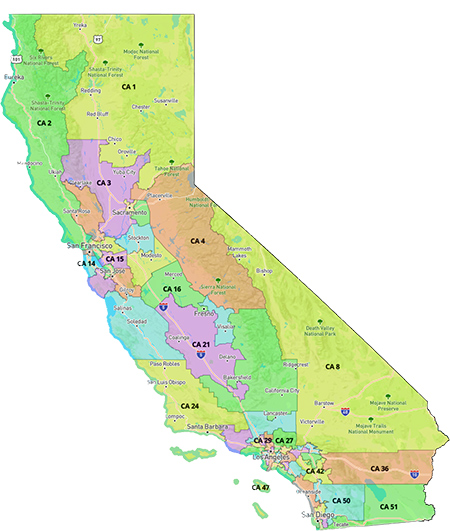April 17, 2018 — When sponsors of the 2010 California ballot initiative that would change the state’s primary system from a closed one to a structure that sends the top two finishers to the general election regardless of political party affiliation, they believed such an alteration would result in more centrist candidates being elected. Thus, the theory was, a new voting procedure would put the extreme candidates from both parties at a disadvantage.
While it’s debatable that centrists have benefited since the “top-two” system went into effect beginning with the 2012 election, the “jungle primary” is clearly having an effect in the many crucial California congressional campaigns this year. While Golden State Democrats are optimistic they can convert competitive seats in Orange County, recent polling in at least one of these seats reveals no clear advantage even as they mount strong efforts in what have traditionally been Republican districts.
In the open 49th CD, the Orange and San Diego County seat that retiring Rep. Darrell Issa (R-Vista) is leaving open, a new Survey USA poll finds the crowded field bunched with a Republican leading the pack. Yet, no candidate even approaches a 20 percent support level.
The S-USA poll (April 6-10; 800 CA-49 registered voters, 535 likely primary voters) gives GOP state Assemblyman Rocky Chavez (R-Oceanside) 16 percent preference, with retired Marine Colonel Doug Applegate (D) following at 12 percent and Democratic newcomer Mike Levin registering nine percent. Applegate advanced to the general in 2016 and held Rep. Issa to a 50.3 percent re-election victory. State Board of Equalization member and former state Assemblywoman Diane Harkey (R) and investor Paul Kerr (D) are next with eight percent apiece. The other 11 candidates — six Republicans, one Democrat, and four minor party or Independent contenders — all are recording support percentages of seven or less.
Adding the Republican and Democratic aggregate percentages, the GOP candidates have a 40-36 percent edge. While President Trump lost this district 51-43 percent, the current Survey USA poll posts his job approval ratio at 46:49 percent positive to negative, which is an improvement. Rep. Issa’s approval index is a similar 42:46 percent.
A quarter of the respondents (25 percent) cite the president as the determining factor in how they will vote in the congressional race, but the analysis did not publish the numbers or ratios for those supporting or opposing a House candidate based upon their feelings about him. Since the intensity level appears stronger among those having an anti-Trump sentiment, it is likely that the majority of those citing the president as the principle factor in determining their vote are more likely to vote Democratic.
The second-most stated vote-determining factor is the border wall (20 percent). Again, the breakdown as to how many respondents would vote Republican or Democratic for the House based upon the candidates’ wall position was not published. Conversely, since intensity on this issue is usually pro-border wall, it is likely that the preponderance of people saying this will determine their vote would be more inclined to vote Republican.
As is evident, this S-USA poll shows no clear leader, and all of the major candidates find themselves hovering within the margin of error. At this point, any combination of the top candidates, including two Republicans or two Democrats, advancing to the general election is possible. While Assemblyman Chavez might have the most support at present, this could quickly change because he will not be among the top money raisers, and the campaign resources each individual possesses as the campaigns head for the stretch will go a long way toward defining just which two will advance.
Similar situations to this political slugfest are unfolding in the open 39th District (retiring Rep. Ed Royce-R), and against 15-term veteran Rep. Dana Rohrabacher (R-Costa Mesa) in the Orange County coastal seat (CA-48). With large candidate fields in all of the aforementioned districts, the June 5 qualifying election is sure to feature some unpredictable conclusions.

